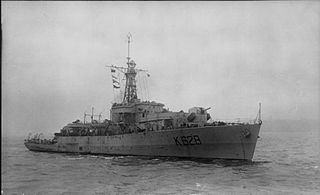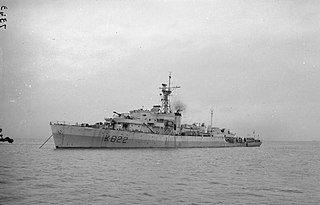
USS Arnold J. Isbell (DD-869), a Gearing-class destroyer, was the only ship of the United States Navy to be named for Arnold J. Isbell, an aircraft carrier captain during World War II. The ship was laid down on 14 March 1945 at Staten Island, New York, by Bethlehem Mariners Harbor, launched on 6 August 1945 and commissioned on 5 January 1946. Constructed too late to see action in World War II, the vessel initially served as a training ship with the United States Atlantic Fleet, before transferring to the Pacific and deploying to Korea during the Korean War and off the Vietnam coast during the Vietnam War. In 1972 Arnold J. Isbell was made part of the reserve training fleet and in 1974, sold to Greece where the ship was renamed Satchouris and served with the Hellenic Navy until being sold for scrap in 2002.

HMAS Duchess was a Daring-class destroyer that served in the Royal Navy as HMS Duchess from 1952 to 1964, and in the Royal Australian Navy (RAN) from 1964 to 1980. She was laid down by John I. Thornycroft and Company, and commissioned into the Royal Navy in 1952.

The eighth HMS Newcastle was a batch 1 Type 42 destroyer of the Royal Navy, launched in 1975. Newcastle was decommissioned on 1 February 2005.

HMS Loch Dunvegan was a Loch-class frigate of the British Royal Navy, named after Loch Dunvegan in Scotland. Launched in 1944, the ship saw service in the Second World War, and in the Mediterranean Fleet in the early 1950s, before being broken up in 1960.

HMS Loch Fada was the lead ship of the Loch-class frigates of the British Royal Navy, built by John Brown & Company of Clydebank, Scotland, and named after Loch Fada in the Inner Hebrides.

HMS Loch Killisport (K628/F628) was a Loch-class frigate of the British Royal Navy, named after Loch Killisport in Scotland. Launched in 1944, the ship was not commissioned until July 1945, and served in post-war repatriation operations in the Far East until decommissioned in April 1946. During this time Prince Philip was an officer on board this ship. Recommissioned in 1950 she served in the Home Fleet for two years, before being extensively modernised for service in the Persian Gulf and Far East. Decommissioned in August 1965, she was sold for scrapping in 1970.

HMS Morecambe Bay was a Bay-class anti-aircraft frigate of the British Royal Navy, named after Morecambe Bay on the north western coast of England. In commission from 1949 until 1956, she saw active service in the Korean War, and was sold to Portugal in 1961 to serve as NRP Dom Francisco de Almeida until 1970.

HMAS Derwent, named for the Derwent River, was a River-class destroyer escort of the Royal Australian Navy (RAN). She was laid down by Williamstown Naval Dockyard in 1959, and commissioned into the RAN in 1964. During the ship's career, she was deployed to South East Asia on 23 occasions, including operations during the Indonesia-Malaysia Confrontation, and escort of the troopship HMAS Sydney to and from the Vietnam War. Multiple flag-showing cruises were also embarked upon, with port visits throughout Asia, the Indian Ocean, and the Pacific Ocean. Derwent was also briefly used to portray a fictional vessel for the British drama series Warship.

HMS Bigbury Bay was a Bay-class anti-aircraft frigate of the British Royal Navy, named for Bigbury Bay in Devon.

HMS Burghead Bay was a Bay-class anti-aircraft frigate of the British Royal Navy, named for Burghead Bay in Morayshire.

HMS Cardigan Bay was a Bay-class anti-aircraft frigate of the British Royal Navy, named after Cardigan Bay, off the coast of Ceredigion, Wales.
HMS St Austell Bay was a Bay-class anti-aircraft frigate of the British Royal Navy, named after St Austell Bay on the south coast of Cornwall. In commission from 1945 until 1956, she served in the Mediterranean Fleet and on the America and West Indies Squadron.
HMS Start Bay (K604/F604) was a Bay-class anti-aircraft frigate of the British Royal Navy, named for Start Bay in Devon. In commission from 1945 to 1946 in the Mediterranean Fleet, she spent most of her career in the Reserve Fleet.

HMS Veryan Bay was a Bay-class anti-aircraft frigate of the British Royal Navy, named after Veryan Bay on the south coast of Cornwall. In commission from 1945 until 1957, she saw service in the Pacific, Mediterranean, and Home Fleets, in the West Indies and in the South Atlantic.

HMS Whitesand Bay was a Bay-class anti-aircraft frigate of the British Royal Navy, named for Whitesand Bay in Cornwall. In commission from 1945 to 1954, she served in the Pacific, Mediterranean, West Indies and Far East Fleets, seeing active service in the Korean War.

HMS Loch Fyne was a Loch-class frigate of the British Royal Navy, built by the Burntisland Shipbuilding Company Ltd, Burntisland, Fife, Scotland, and named after Loch Fyne in Scotland. The ship was launched in 1944, and served at the end of World War II. Recommissioned in 1951, she served in the Persian Gulf and was scrapped in 1970.

HMNZS Rotoiti (F625) was a Loch-class frigate of the Royal New Zealand Navy (RNZN), which had formerly served in the British Royal Navy as HMS Loch Katrine at the end of World War II.

HMNZS Hawea (F422), formerly HMS Loch Eck (K422), was one of six Loch-class frigates that served in both the Royal Navy (RN) and the Royal New Zealand Navy (RNZN). The ship was laid down by Smiths Dock on 25 October 1943, launched on 25 April 1944 and commissioned into the Royal Navy as HMS Loch Eck on 7 November 1944.

HMS Loch Achray was a Loch-class frigate of the Royal Navy. She was built by Smith's Dock Co. Ltd. in South Bank-on-Tees and launched on 7 July 1944. After service in World War II, she was sold to the Royal New Zealand Navy and renamed HMNZS Kaniere (F426) in September 1948. After service in the Korean War, she was used as a training ship from 1957. She was sold in 1966 for breaking up in Hong Kong.

HMS Loch Achanalt was a Loch-class frigate of the Royal Navy that was loaned to and served with the Royal Canadian Navy during World War II. Ordered from Henry Robb, Leith, on 24 July 1942 as a River-class frigate, the order was changed, and ship laid down on 14 September 1943, and launched by Mrs. A.V. Alexander, wife of the First Lord of the Admiralty on 23 March 1944 and completed on 11 August 1944. After the war she was transferred to the Royal New Zealand Navy and renamed Pukaki.

















